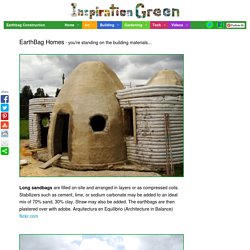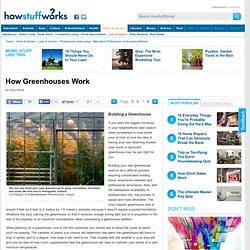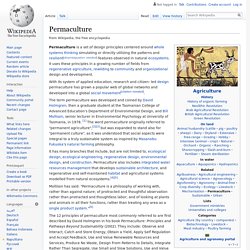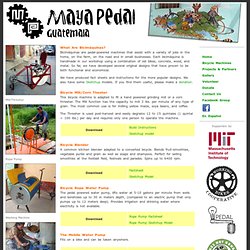

Softshelter provides disaster relief housing with a personal touch. The softshelter housing solution for disaster relief situations (Image by Molo Design) Image Gallery (23 images) Canadian design firm Molo has created a cheap and comfortable housing innovation for disaster relief situations. Dubbed "softshelter," the system has been designed to create personal space within in a communal shelter, thus providing individuals or families with some privacy during a time of hardship. View all To illustrate the practicality of the system, a member of the Molo team has volunteered to camp out in a softshelter module within the Molo workshop space for a period of several weeks.
The softshelter modules are made from 100 percent recycled materials designed for re-use over a long period if time. The Molo team has also added small touches to make the relief shelter feel that little bit more personal. Leaving and Breathing Green Walls from Nendo. Designers at Nendo sure know how to play with ideas and create wild things-literally.

The pictures below are taken in an actual house in Tokyo. The fact that the property is located on a riverbank and it had some vegetation growing on the external facades of the building, inspired the designers to come up with green separating walls for the interior also. Earthbag Construction. EarthBag Homes - you're standing on the building materials... earthbag home Long sandbags are filled on-site and arranged in layers or as compressed coils.

Stabilizers such as cement, lime, or sodium carbonate may be added to an ideal mix of 70% sand, 30% clay. Straw may also be added. The earthbags are then plastered over with adobe. Arquitectura en Equilibrio (Architecture in Balance) flickr.com earthbag home Plastic bags recycled into plastic bags -- if plastic does not break down for a thousand years, this building is sure to last several lifetimes. Earthbag construction Foundations differ as per site. A Low Impact Woodland Home. Building a Greenhouse" If you want the biggest tomatoes in your neighborhood next season, need somewhere to over-winter your orchids or love the idea of having your own blooming flowers year round, a backyard greenhouse may be just right for you.

Building your own greenhouse used to be a difficult process requiring complicated building plans, expensive materials and professional assistance. Now, with the widespread availability of prefabricated kits, the process is easier and more affordable. The most popular greenhouse size is around 8 feet by 6 feet (2.4 meters by 1.8 meters), probably because it doesn't require a poured foundation. Whatever the size, placing the greenhouse so that it receives enough strong light and is in proportion to the rest of the property is an important consideration when considering a greenhouse addition. Permaculture.
With its system of applied education, research and citizen- led design permaculture has grown a popular web of global networks and developed into a global social movement[citation needed].

The term permaculture was developed and coined by David Holmgren, then a graduate student at the Tasmanian College of Advanced Education's Department of Environmental Design, and Bill Mollison, senior lecturer in Environmental Psychology at University of Tasmania, in 1978. [1] The word permaculture originally referred to "permanent agriculture",[3] but was expanded to stand also for "permanent culture", as it was understood that social aspects were integral to a truly sustainable system as inspired by Masanobu Fukuoka’s natural farming philosophy. It has many branches that include, but are not limited to, ecological design, ecological engineering, regenerative design, environmental design, and construction. History[edit] Several individuals revolutionized the branch of permaculture. In Australian P.A. Introduction to Permaculture - 18 part webinar with Bill Wilson of Midwest Permaculture. Interplanting and Beyond, An Excerpt from Gaia’s Garden // May 1st, 2012 // No Comments » // Uncategorized This coming Sunday, May 6, is International Permaculture Day!

To celebrate, this week we’ll be sharing some classic excerpts from one of our perennial bestsellers, Gaia’s Garden by Toby Hemenway. Healthy food and garden education. Pedal powered water pumps, threshers, blenders, tile makers and more. What Are Bicimáquinas?

Bicimáquinas are pedal-powered machines that assist with a variety of jobs in the home, on the farm, on the road and in small businesses. Each bicimáquina is handmade in our workshop using a combination of old bikes, concrete, wood, and metal. So far, we have developed several original designs that have proven to be both functional and economical.
We have produced fact sheets and instructions for the more popular designs. We also have some Sketchup models. Bicycle Mill/Corn Thesher This bicycle machine is adapted to fit a hand powered grinding mill or a corn thresher. The Thresher is used post-harvest and easily degrains 12 to 15 quintales (1 quintal = 100 lbs.) per day and requires only one person to operate the machine. The Most Beautiful Green Home Building Construction Project Ever? Design Published on April 9th, 2009 | by ziggy April 9th, 2009 by ziggy My jaw dropped when I first watched this video tour of a beautiful owner-built green building construction project in Oregon.

This particular green building is made entirely out of cob, a mixture of clay, sand, and straw. Meka Bunch of Wolf Creek, Oregon built this stunning cob house over a four year period.